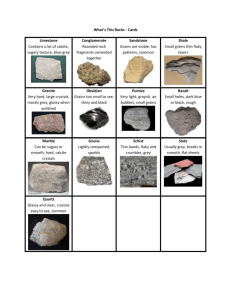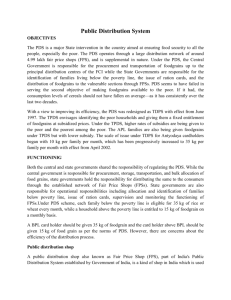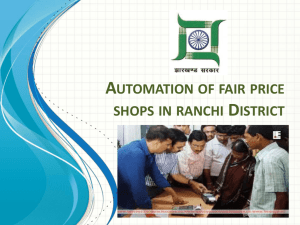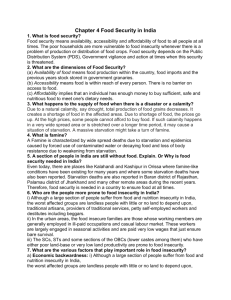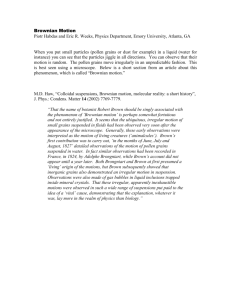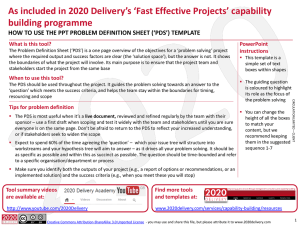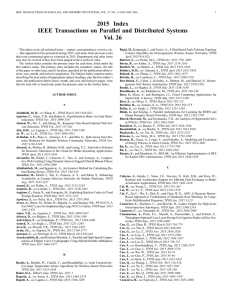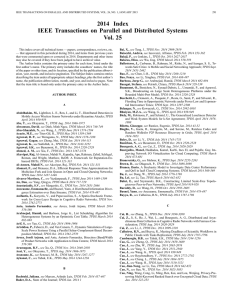Public Distribution System- objectives, functioning, limitations
advertisement
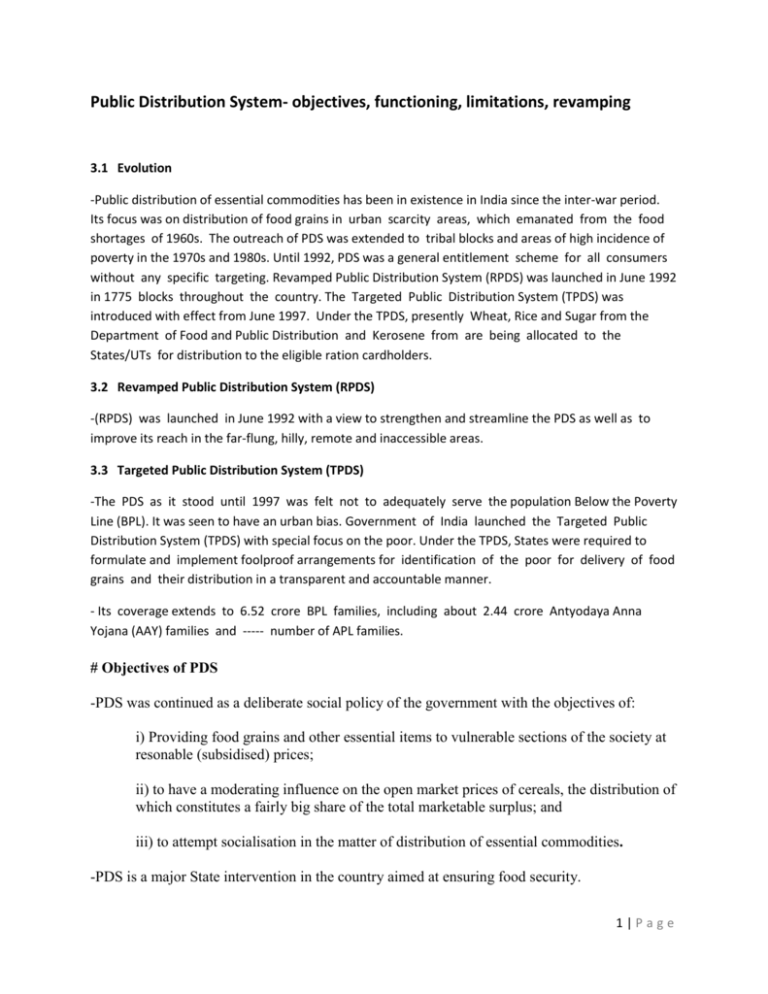
Public Distribution System- objectives, functioning, limitations, revamping 3.1 Evolution -Public distribution of essential commodities has been in existence in India since the inter-war period. Its focus was on distribution of food grains in urban scarcity areas, which emanated from the food shortages of 1960s. The outreach of PDS was extended to tribal blocks and areas of high incidence of poverty in the 1970s and 1980s. Until 1992, PDS was a general entitlement scheme for all consumers without any specific targeting. Revamped Public Distribution System (RPDS) was launched in June 1992 in 1775 blocks throughout the country. The Targeted Public Distribution System (TPDS) was introduced with effect from June 1997. Under the TPDS, presently Wheat, Rice and Sugar from the Department of Food and Public Distribution and Kerosene from are being allocated to the States/UTs for distribution to the eligible ration cardholders. 3.2 Revamped Public Distribution System (RPDS) -(RPDS) was launched in June 1992 with a view to strengthen and streamline the PDS as well as to improve its reach in the far-flung, hilly, remote and inaccessible areas. 3.3 Targeted Public Distribution System (TPDS) -The PDS as it stood until 1997 was felt not to adequately serve the population Below the Poverty Line (BPL). It was seen to have an urban bias. Government of India launched the Targeted Public Distribution System (TPDS) with special focus on the poor. Under the TPDS, States were required to formulate and implement foolproof arrangements for identification of the poor for delivery of food grains and their distribution in a transparent and accountable manner. - Its coverage extends to 6.52 crore BPL families, including about 2.44 crore Antyodaya Anna Yojana (AAY) families and ----- number of APL families. # Objectives of PDS -PDS was continued as a deliberate social policy of the government with the objectives of: i) Providing food grains and other essential items to vulnerable sections of the society at resonable (subsidised) prices; ii) to have a moderating influence on the open market prices of cereals, the distribution of which constitutes a fairly big share of the total marketable surplus; and iii) to attempt socialisation in the matter of distribution of essential commodities. -PDS is a major State intervention in the country aimed at ensuring food security. 1|Page # Functioning of PDS 1) Procurement of Food Grains. 2) Identification of poor and needy. 3) Issue of ration cards to poor people. 4) Transportation of food grains to all Fair price shops. 5) Selling Food grains to all the needy people. 4.1 Identification of BPL in Rural areas -The Census is to be conducted by State Governments/UTs with the technical and financial support of the M/o Rural Development. -The classification of households is to be done in three steps. First step would be to apply an exclusion criteria. The exclusion criteria would comprise of Households owning Motorized vehicles, having Kisan Credit Card with the credit limit of Rs.50,000 and above; having any member as Government Employee or earning more than Rs. 10,000 p.m.; paying income tax or professional tax; having land, tubewell, etc. -The categories of households that would be compulsorily included, subject to exclusion criteria above, are those relating to Households without shelter; Destitutes/living on alms; Manual scavengers; Primitive Tribal Groups; and Legally released bonded labourers. -The remaining households will then be assigned deprivation scores depending on the number of deprivation indicators i.e. Households with only one room, with kucha walls and kucha roof. -The BPL Census would be conducted along with Caste Census being conducted by the office of RGI. 4.2 Identification of BPL in Urban areas -For urban areas, the Planning Commission set up an Expert Group headed by Prof. S R Hashim methodology for identification of families living below poverty line in the urban areas. poverty be identified in urban areas through the identification of specific ‘vulnerabilities’ covering three broad categories namely, residential, occupational and social. 5. DISTRIBUTION OF COARSEGRAINS AND ADDRESSING THE NUTRITION CONCERNS 5.1 Coarse grains under TPDS 2|Page - if nutrition security is one of the considerations of TPDS, the government may explore the possibility of including more commodities under TPDS. For example, cereals such as jowar, bajra, and also pulses could be introduced in TPDS because of nutritional considerations. It was further stated that presently the country has a shortage of these commodities. Moreover, the introduction of these commodities may encourage production of these crops especially in dry land areas. -States like Gujarat, Haryana, Karnataka and Rajasthan are among the few States where coarse grain have been sought for distribution under TPDS. Bajra, Jawar, Ragi and other millets are highly nutritious and are known to possess several medicinal properties. 5.2 Addressing the nutritional concerns -Supreme Court has directed that as a one-time measure, it is absolutely imperative to reserve another 5 million tonnes of food grains for distribution to the 150 poorest districts or the extremely poor and vulnerable sections of our society. - Wheat Based Nutrition Programme under the Integrated Child Development Services (ICDS), Rajiv Gandhi Scheme for Empowerment of Adolescent Girls (RGSEAG) of the Ministry of WCD and the Mid Day Meals Scheme of the Ministry of Human Resource Development, among others. These schemes also contribute in addressing the problem of malnutrition. -Provisions may be made to have legal entitlements under the schemes like ICDS, Mid Day Meal etc. and the use of coarse grains while providing cooked food under such schemes should be encouraged. 6. The challenges noted were: 6.1 Allocation 1. Non – availability /delay of utilization information to the Centre from States. 2. Non - availability / delay of closing balance details and updated card status at State level from the districts, block and FPS levels. 3. Inaccurate data reporting by FPS 4. Longer time taken for allocation cycle 6.2 Movement 1. Absence of truck tracking systemleading to delayed delivery, diversions, siphoning etc. 3|Page 2. Non-standard transportation rates 3. Cartel formation by transporters 4. Late submission of demand drafts/cash by FPS for lifting leads to sub optimal route planning. 6.3 Storage and Quality Control (QC) 1. Non-availability of stock positions in few states leads to inappropriate allocation and excess stock build up at intermediary storage points 2. Poor quality of packaging leads to loss of food grains 3. Extensive use of hooks leads to spillage 4. Insufficient godown capacity of intermediate storage points result in multiple shipments 5. Temperature fluctuations due to weather leads to variations in weight of food grains 6. Loss of food grains due to infestation 7. Manpower shortage leads to delay in dispatches and non compliance to policies 6.4 Finance 1. Poor financial condition of FPS and GPSS /WCCS (in Assam) 2. Cost and time incurred on preparation of multiple DDs by FPS results in increased financial burden on the FPS/GPSS 6.5 Licensing and Regulation 1. Inadequate monitoring leading to diversion of stock 2. Selection of inappropriate dealer leading to malpractices 3. Lack of standard selection procedure and guidelines 4. Difficulty in identification of elapsed licenses 6.6 Grievance Redressal 1. Absence of response and monitoring mechanism because of which, higher authorities are unaware of number and status of grievances registered and thus grievances are not getting resolved on time 2. The service level agreements for grievance redressal are not clearly defined 3. Bogus complaints result in wastage of officials’ time 4|Page 4. Lack of integration between various complaint and registration channels leads to multiple actions at different levels 5|Page 7. MEASURES TAKEN FOR STREAMLINING AND STRENGTHENING OF TPDS & REFORMS IN TPDS 7.1 Nine point action plan 1 States should undertake a campaign to review BPL/AAY list to eliminate ghost ration cards. implementation of the action plan has resulted in elimination of a total of 208.58 lakh bogus/ineligible ration cards in 26 States. 2 Strict action should be taken against the guilty to ensure leakage free distribution of food grains. 3 For sake of transparency, involvement of elected PRI members in distribution of food grains should be ensured. -Adoption and implementation of revised Model Citizens’ Charter - To make TPDS operations transparent. Introduction of Monthly Certification of Delivery of Food Grains at Fair Price Shops, and their Distribution to Ration Card Holders monthly certification by village panchayats / urban local bodies/vigilance committees/Women’s Self Help Groups (SHGs). -Publicity-cum-awareness Campaign - To facilitate greater public scrutiny of functioning of TPDS. -Community participation in monitoring of PDS should be encouraged by taking measures such as social audit by local bodies/ community groups/ NGOs, SMS based information made available to Ration Card holders, etc. -There should be a responsive Grievance Redressal Mechanism, display of information about rights and duties in every FPS, helpline in the form of Call-centre with toll-free numbers and web based complaint registration and monitoring system. As provided in the draft National Food Security Legislation, Grievance Redressal Mechanism is to be set up at the National, State and district levels with necessary infra structure and staff. A scheme may be prepared to strengthen the Grievance Redressal Mechanism. 4 BPL/AAY lists should be displayed on all FPSs. 5 District-wise and FPS-wise allocation of food grains should be put up on websites and other prominent places, for public scrutiny. 6 Wherever possible, doorstep delivery of food grains should be ensured by States, instead of letting private transporters/wholesalers to transport goods. 7. Timely availability of food grains at FPS level and fixed dates of distribution to ration cardholders should be ensured. 8 Training of members of FPS level Vigilance Committees should be ensured. 9 Computerization of TPDS operations is undertaken. 6|Page -Digitization of ration cards (Andhra Pradesh, Chhattisgarh, Tamil Nadu, Madhya Pradesh, Karnataka, etc.) -Computerized allocation to fair price shops (Chhattisgarh, Delhi, Madhya Pradesh, Tamil Nadu etc.), -Issue of smart cards in place of ration cards (Andhra Pradesh, Orissa, etc.), -Grievance redressal (Andhra Pradesh, Chhattisgarh, Tamil Nadu, Kerala, etc.) -Other technology based initiatives are also being taken in the field of TPDS like use of GPS technology (Chhattisgarh, Tamil Nadu) for tracking of vehicles carrying TPDS commodities, -SMS based monitoring of movement of vehicles and reporting of dispatch/ arrival of TPDS commodities (Chhattisgarh, UP, TN) and use of web-based citizens’ portal (Chattisgarh). # Aadhaar can be leveraged by PDS in a number of ways: 1. Ration card registration 2. Cutting down diversion and pilferage through elimination of fake beneficiaries 3. Providing authentication services 4. Aadhaar-linked payments # Other Measures to improve the efficiency of FPS operations -Distribution of wheat flour/fortified wheat flour under TPDS for nutritional improvement of targeted beneficiaries. -Cooperatives, Women’s Self Help Groups, Village Panchayats, Urban Local Bodies Allotment of Fair Price Shops to Institutions and Groups. -PDS coupled with employment generation programme should create a scenario wherein price control and poverty alleviation can converge. -Encourage community based storage facilities to tackle distribution and availability problems. -Track the movement of food grains by use of GPS. # Converting Targeted PDS to Universal PDS -TN and CG have had success in following this scheme .( CPI recommends this idea too) It will help with: 1) Nullifying the requirement to identify the poor. (Although to a certain extent this has to be done and can be managed by using Aadhar) 2) It may reduce leakages to pvt retail since everyone will be able to buy from the FPS. 7|Page #Creation of FPS-cum –godowns -Financial Assistance from Central Government will be provided to the extent of 50% of the cost of construction or a maximum of Rs.1 lakh per FPS-cum-Godowns. The remaining 50% should be contributed by the State/UT from its own resources. -These FPS-cum-Godowns shall be opened in backward regions, tribal areas, hilly and inaccessible areas only #NEED FOR PROVIDING ESSENTIAL ITEMS TO PUBLIC AND ADDING MORE ITEMS UNDER TPDS -Sale of non-PDS items in FPS- To make operations of FPS economically viable, the State/UT Governments have been advised to allow FPS licensees to enlarge the basket of commodities by allowing sale of non-PDS items for daily use as per local requirements. - Inclusion of non-PDS items like toothpaste, mobile recharge etc. through PDS by negotiating intermediary margins would involve further complex procedures of contracting, tracking the inventories etc, which can complicate the administrative procedures and lead to further leakages based on past experience, expanding the basket of items is considered as one of the effective measures to address the viability of FPSs. -Increased commission to FPS dealers. -As a measure to fight spurt in prices of common items and to protect the consumers, the Market Intervention Scheme for providing facilities of non-formal PDS should be finalised at the earliest. -As a measure to fight spurt in prices of common items and to protect the consumers, the Market Intervention Scheme for providing facilities of non-formal PDS should be finalised at the earliest. 8|Page 9|Page


